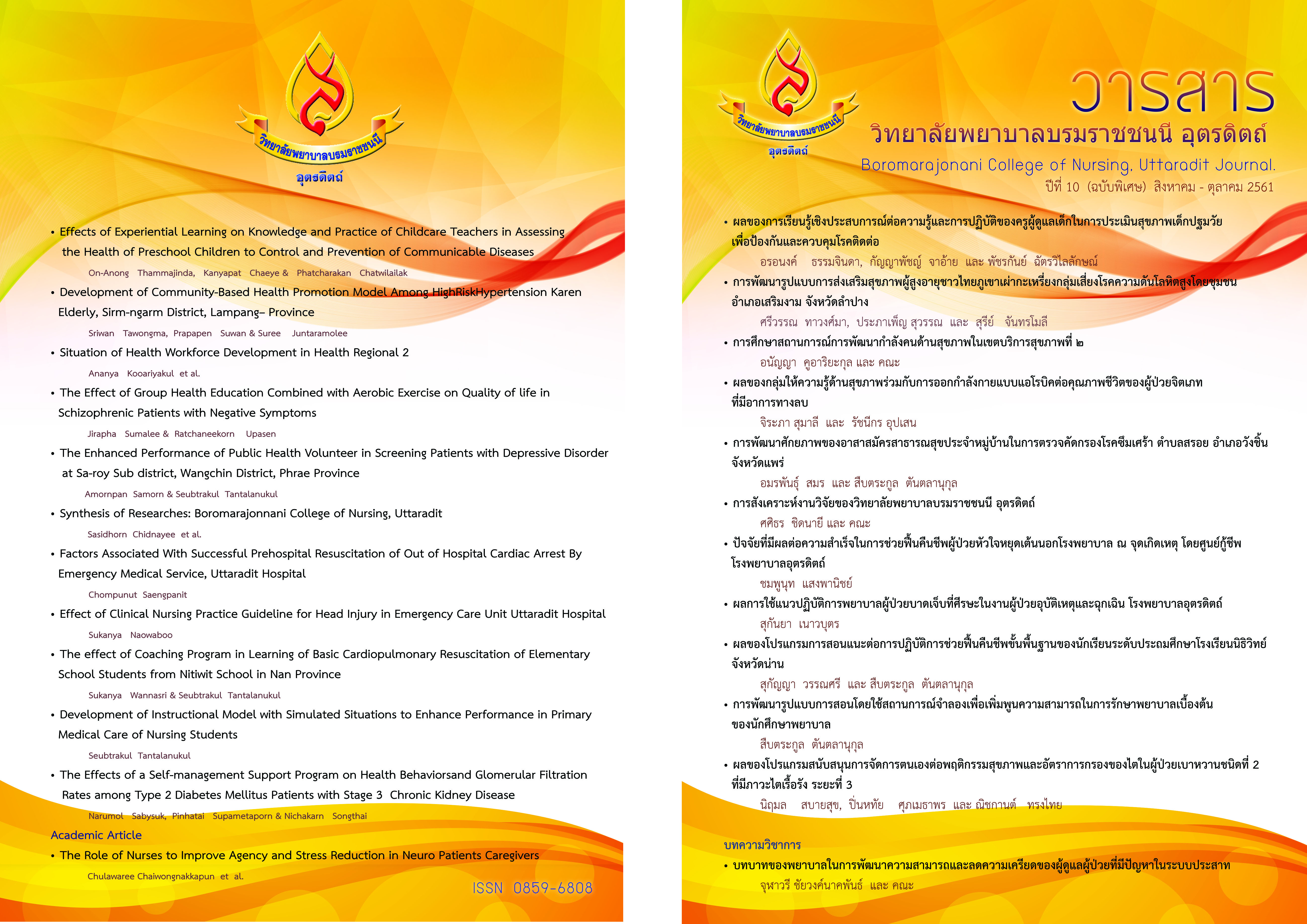ปัจจัยที่มีผลต่อความสำเร็จในการช่วยฟื้นคืนชีพผู้ป่วยหัวใจหยุดเต้นนอกโรงพยาบาล ณ จุดเกิดเหตุ โดยศูนย์กู้ชีพโรงพยาบาลอุตรดิตถ์
Main Article Content
บทคัดย่อ
ภาวะหัวใจหยุดเต้นนอกโรงพยาบาลเป็นสาเหตุการเสียชีวิตที่สำคัญโดยอัตราการรอดชีวิตขึ้นกับหลายปัจจัย แม้มีการพัฒนาองค์ความรู้ในการรักษาอย่างต่อเนื่องอัตรารอดชีวิตยังต่ำ การวิจัยครั้งนี้มีวัตถุประสงค์เพื่อศึกษาปัจจัยที่มีผลต่อความสำเร็จในการช่วยฟื้นคืนชีพผู้ป่วยหัวใจหยุดเต้นนอกโรงพยาบาล ณ จุดเกิดเหตุ เก็บรวบรวมข้อมูลแบบย้อนหลังในผู้ป่วยหัวใจหยุดเต้นนอกโรงพยาบาลที่อายุมากกว่า 18 ปี ที่ได้รับการช่วยฟื้นคืนชีพโดยศูนย์กู้ชีพโรงพยาบาลอุตรดิตถ์ ตั้งแต่วันที่ 1 มกราคม พ.ศ.2557 ถึง 31 ธันวาคม พ.ศ.2560 วิเคราะห์ข้อมูลด้วยสถิติเชิงพรรณนาและการถดถอยโลจิสติคเพื่อหาปัจจัยที่สัมพันธ์กับความสำเร็จในการช่วยฟื้นคืนชีพ ณ จุดเกิดเหตุ
ผลการวิจัยพบว่ามีผู้ป่วยหัวใจหยุดเต้นนอกโรงพยาบาลที่ได้รับการช่วยฟื้นคืนชีพ ทั้งหมด 139 ราย ช่วยฟื้นคืนชีพสำเร็จร้อยละ 52.5 พบปัจจัยที่มีผลต่อความสำเร็จในการช่วยฟื้นคืนชีพที่นัยสำคัญทางสถิติที่ระดับ .05 คือ การได้รับการกู้ชีพเบื้องต้นในที่เกิดเหตุ (OR= 24.188; 95%CI= 6.827 - 85.698) และการมีผู้พบเห็นขณะหัวใจหยุดเต้น (OR =19.529; 95%CI= 6.339 - 60.168) สาเหตุของหัวใจหยุดเต้นเกิดจากการบาดเจ็บเป็นปัจจัยที่ทำให้โอกาสการช่วยฟื้นคืนชีพสำเร็จลดลง (OR= 0.085; 95%CI= 0.023 - 0.316) ควรส่งเสริมนโยบายให้ชุมชนตระหนักถึงภาวะหัวใจหยุดเต้น โดยให้ความรู้และฝึกอบรมประชาชนทั่วไปให้ทำการกู้ชีพเบื้องต้นอย่างมีประสิทธิภาพทันที เมื่อพบผู้ป่วยหัวใจหยุดเต้นนอกโรงพยาบาล
Article Details
บทความหรือข้อคิดเห็นใดใดที่ปรากฏในวารสารวิจัยการพยาบาลและวิทยาศาสตร์สุขภาพ เป็นวรรณกรรมของผู้เขียน ซึ่งบรรณาธิการหรือสมาคมศิษย์เก่า ไม่จำเป็นต้องเห็นด้วย และบทความที่ได้รับการตีพิมพ์เผยแพร่ถือเป็นลิขสิทธิ์ของวารสารวิจัยการพยาบาลและวิทยาศาสตร์สุขภาพ
References
2. Hansen M., Schmicker R., Newgard C.,Grunau B., Scheuermeyer F., Cheskes S., et al. (2018).
Time to epinephrine administration and survival from non shockable out of hospital cardiac arrest among children and adult.Circulation,137(11),1161-1168.
3. Jabre P., Penaloza A., Pinero D.,Duchateau F., Borron S. & Javaudin F., et al. (2018).Effect of
bag mask ventilation vs endotracheal during cardiopulmonary resuscitation on Neurological outcome after out-of-hospital cardiorespiratory arrest. JAMA,319(8),779-87.
4. Morais D.,Carvalho D. &Correa A.(2014). Out-of-hospital cardiac arrest : determinant factors for immediate survival after cardiopulmonary resuscitation. Revista Latino-Americanade Enfermagem, 22(4),562-568.
5. Nongchang P., Laohasiriwong W., Pitaksanurat S. & Boonsirikamchai P. (2017). Intravenous fluid administration and the survival of pre hospital resuscitated out of hospital cardiac arrest patients in Thailand. Journal of Clinical and Diagnostic Reserch, 11(9), 29-32.
6. Ong M., Shin S., Souza N., Tanaka H., Nishiuchi T. & Song K., et al.(2015).Outcomes for out-of-hospital cardiac arrests across 7 countries in Asia: The Pan Asian Resuscitation Outcomes Study (PAROS).Resuscitation, 96,100–108.
7. Photipim M., Laohasiriwong W., Thinkhamrop B., Sethasathien A. & Hurst C. (2016).The effect of response time on survival among non traumatic out of hospital cardiac arrest patients in Thailand. The Journal of Health Research, 30(1),19-24.
8. Soholm H., Hassager C., Lippert F., Jensen M., Thomsen J., Friberg H., et al. (2015). Factors associated with successful resuscitation after out-of-hospital cardiac arrest and temporal trends in survival and comorbidity. Annals of Emergency Medicine, 65(5), 523-531.
9. Syvaoja S., Salo A., Uusaro A.,Jantti H. & Kuisma M. (2018). Witnessed out of hospital cardiac arrest- effect of emergency dispatch recognition. ActaAnaesthesiologica Scandinavica, 62(4), 558-567.
10. Yeeeng U.(2011). Factors associated with successful resuscitation of out-of-hospital cardiac arrest at Rajavithi hospital’s narenthorn emergency medical service center, Thailand. Asia-Pacific Journal of Public Health, 23(4), 601–607. (in Thai)

